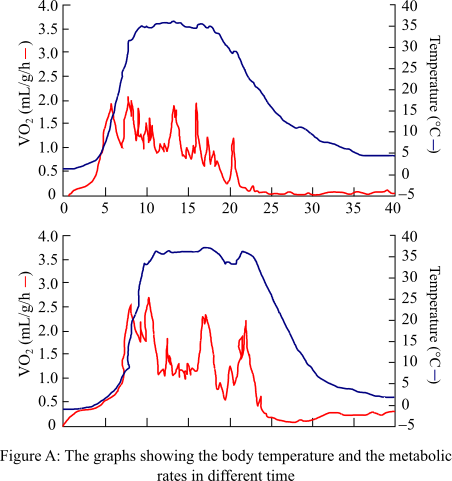
Concept explainers
To analyze:
The mechanisms and the processes that occurs in the squirrels for raising their body temperatures.
Given:
The arctic ground squirrels were kept in the hibernating chambers by the researchers. These squirrels can build the burrows that can reach –10°C. The hibernating chambers in the laboratory were held at either +2°C or –12°C. It was observed that all the squirrels taken into consideration entered bouts of torpor repeatedly. The body temperatures (Tb) and the
The given table depicts the mean values of the metabolic rate and the temperature during the rewarming phase with their standard errors. The observation taken is for the two groups of squirrels at the different temperatures.


Introduction:
There are two types of animals: ectotherms and endotherms. Ectotherms have a constant body temperature, while the endotherms have to change their internal body temperature according to the temperature outside the body.
Want to see the full answer?
Check out a sample textbook solution
Chapter 39 Solutions
Life: The Science of Biology
- How does sea otters stay warm differ from the way in which seals stay warm? Explain the mechanism for both.arrow_forwardPlease use the image attached This is For Meal Worm Data: • During 2 weeks(14 days) in 6 Celsius temperature from 10 meal worm none shedded and none died • During 2 weeks(14 days) in 26 Celsius temperature 2 meal worms out of 10 shedded and 1 died having only 9 alive • During 4 weeks(28 days) in 6 Celsius temperature from 10 meal worms none shedded and none died they are just slow • During 4 weeks(28 days) in 26 Celsius temperature 2 meal worms out of 10 shedded and 1 died having only 9 alive also there was 1 pupae and they got slow because before they were fast Please please Site your sources for the information you found and Avoid saying: GROW, PROVE, IN THIS EXPERIMENT Common problems with poorly written lab reports. •Use the abstract to introduce the report instead of to summarize. •Refer to the specimen by common name instead of by scientific name. •Refer to errors that may have occurred without discussing the evidence that those errors actually did occur Can you…arrow_forwardPlease use the image attached This is For Meal Worm Data: • During 2 weeks(14 days) in 6 Celsius temperature from 10 meal worm none shedded and none died • During 2 weeks(14 days) in 26 Celsius temperature 2 meal worms out of 10 shedded and 1 died having only 9 alive • During 4 weeks(28 days) in 6 Celsius temperature from 10 meal worms none shedded and none died they are just slow • During 4 weeks(28 days) in 26 Celsius temperature 2 meal worms out of 10 shedded and 1 died having only 9 alive also there was 1 pupae and they got slow because before they were fast Please please Site your sources for the information you found and Avoid saying: GROW, PROVE, IN THIS EXPERIMENT Common problems with poorly written lab reports. • Use the abstract to introduce the report instead of to summarize. • Refer to the specimen by common name instead of by scientific name. • Refer to errors that may have occurred without discussing the evidence that those errors actually did occur Can you…arrow_forward
- Describe the wood frog's adaptation which is the ability to freeze its body. Is this adaptation behavioral, chemical, or physical adaptation? How does this adaptation help the wood frog survive?arrow_forwardDescribe the behavioural and physiological adaptations that enable many rodents to thrive in arid environments (long answer)arrow_forwardWhen reptiles after their behavior in order to help control their body temperature, what characteristic of living organisms is being shown?arrow_forward
- Complete the missing body temperatures for turtles. And answer questions 3 and 4arrow_forwardWhen people move to hot climates, their bodies increase sweat production to manage the heat-induced body stress. Individuals increasing sweat production implies that they have adapted the change in temperature Question 4 a. False b. Truearrow_forwardWith explanations examples, distinguish between aestivation, hibernation and dormancyarrow_forward
- A desert beetle in northern Mexico can change its behavior to regulate its body temperature above 35c. When would being in a burrow not be the best option for cooling off?arrow_forwardPrinciples behind hibernation of bearsarrow_forwardGive typing answer with explanation and conclusion What factors stimulates fleas to come out of diapause? Summer season Light intensity Mating calls Vibrationsarrow_forward
